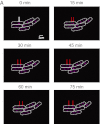Spatial ordering of chromosomes enhances the fidelity of chromosome partitioning in cyanobacteria
- PMID: 22869746
- PMCID: PMC3427121
- DOI: 10.1073/pnas.1211144109
Spatial ordering of chromosomes enhances the fidelity of chromosome partitioning in cyanobacteria
Abstract
Many cyanobacteria have been shown to harbor multiple chromosome copies per cell, yet little is known about the organization, replication, and segregation of these chromosomes. Here, we visualize individual chromosomes in the cyanobacterium Synechococcus elongatus via time-lapse fluorescence microscopy. We find that chromosomes are equally spaced along the long axis of the cell and are interspersed with another regularly spaced subcellular compartment, the carboxysome. This remarkable organization of the cytoplasm along with accurate midcell septum placement allows for near-optimal segregation of chromosomes to daughter cells. Disruption of either chromosome ordering or midcell septum placement significantly increases the chromosome partitioning error. We find that chromosome replication is both asynchronous and independent of the position of the chromosome in the cell and that spatial organization is preserved after replication. Our findings on chromosome organization, replication, and segregation in S. elongatus provide a basis for understanding chromosome dynamics in bacteria with multiple chromosomes.
Conflict of interest statement
The authors declare no conflict of interest.
Figures




Similar articles
-
Spatial and temporal organization of chromosome duplication and segregation in the cyanobacterium Synechococcus elongatus PCC 7942.PLoS One. 2012;7(10):e47837. doi: 10.1371/journal.pone.0047837. Epub 2012 Oct 24. PLoS One. 2012. PMID: 23112856 Free PMC article.
-
Cyanobacterial multi-copy chromosomes and their replication.Biosci Biotechnol Biochem. 2020 Jul;84(7):1309-1321. doi: 10.1080/09168451.2020.1736983. Epub 2020 Mar 11. Biosci Biotechnol Biochem. 2020. PMID: 32157949 Review.
-
ParA-like protein influences the distribution of multi-copy chromosomes in cyanobacterium Synechococcus elongatus PCC 7942.Microbiology (Reading). 2018 Jan;164(1):45-56. doi: 10.1099/mic.0.000577. Epub 2017 Nov 21. Microbiology (Reading). 2018. PMID: 29165230
-
Coordination of Polyploid Chromosome Replication with Cell Size and Growth in a Cyanobacterium.mBio. 2019 Apr 23;10(2):e00510-19. doi: 10.1128/mBio.00510-19. mBio. 2019. PMID: 31015323 Free PMC article.
-
Bacterial chromosome organization and segregation.Cold Spring Harb Perspect Biol. 2010 Feb;2(2):a000349. doi: 10.1101/cshperspect.a000349. Cold Spring Harb Perspect Biol. 2010. PMID: 20182613 Free PMC article. Review.
Cited by
-
Ultrastructure of compacted DNA in cyanobacteria by high-voltage cryo-electron tomography.Sci Rep. 2016 Oct 12;6:34934. doi: 10.1038/srep34934. Sci Rep. 2016. PMID: 27731339 Free PMC article.
-
Compartmentalization and organelle formation in bacteria.Curr Opin Cell Biol. 2014 Feb;26:132-8. doi: 10.1016/j.ceb.2013.12.007. Epub 2014 Jan 16. Curr Opin Cell Biol. 2014. PMID: 24440431 Free PMC article. Review.
-
New approaches to understanding the spatial organization of bacterial genomes.Curr Opin Microbiol. 2014 Dec;22:15-21. doi: 10.1016/j.mib.2014.09.014. Epub 2014 Oct 7. Curr Opin Microbiol. 2014. PMID: 25305533 Free PMC article. Review.
-
Mitotic antipairing of homologous and sex chromosomes via spatial restriction of two haploid sets.Proc Natl Acad Sci U S A. 2018 Dec 26;115(52):E12235-E12244. doi: 10.1073/pnas.1809583115. Epub 2018 Dec 10. Proc Natl Acad Sci U S A. 2018. PMID: 30530674 Free PMC article.
-
Single-cell screening of photosynthetic growth and lactate production by cyanobacteria.Biotechnol Biofuels. 2015 Nov 25;8:193. doi: 10.1186/s13068-015-0380-2. eCollection 2015. Biotechnol Biofuels. 2015. PMID: 26613003 Free PMC article.
References
Publication types
MeSH terms
Grants and funding
LinkOut - more resources
Full Text Sources
Other Literature Sources

